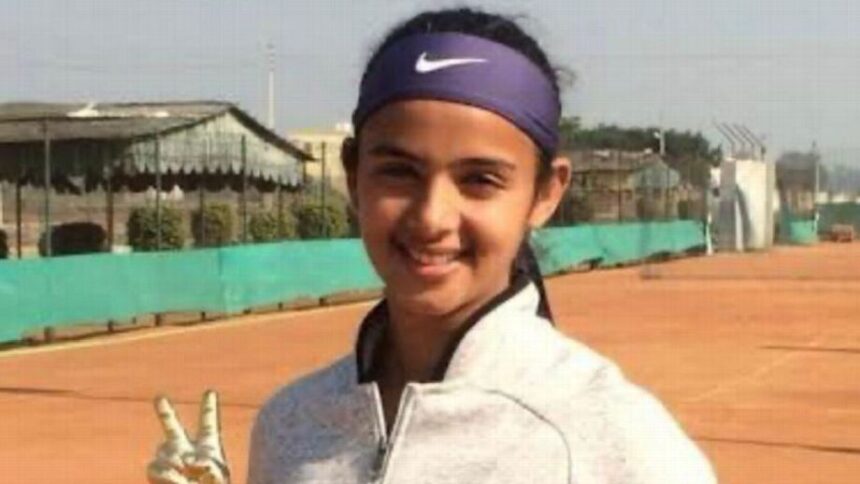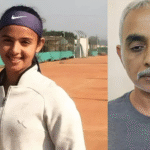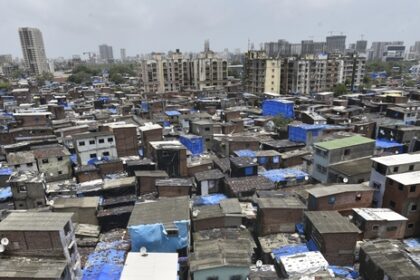A Nation Stunned — The Tragic Fall of Radhika Yadav
On a quiet morning in July 2025, the world of Indian sports was rocked by a tragedy that no one could have imagined. Radhika Yadav, a rising star in Indian tennis, was shot dead—by her own father. The news broke with the blunt force of disbelief. For many, it wasn’t just a personal tragedy—it was a national heartbreak. A promising career had been cut short, not by injury, not by competition, but by a brutal act within the walls of her own home.
Radhika was just 21. A top-seeded junior player not long ago, she had steadily made her way into the professional circuit, earning accolades for her disciplined playing style and unmatched endurance on the court. Her performances in domestic championships had earned her a reputation as one of the most mentally composed players of her generation. Though she hadn’t yet made a Grand Slam debut, many in the Indian Tennis Federation believed it was only a matter of time. She had already been selected for multiple international training camps and was being considered for the national squad ahead of the Asian Games.
What makes the tragedy even more harrowing is the reported motive—or rather, the lack of one that makes any rational sense. Initial police reports indicate a domestic argument that escalated fatally. Neighbors heard raised voices, followed by the crack of gunfire. By the time authorities arrived at the scene, Radhika was found lifeless, and her father—still holding the weapon—was taken into custody without resistance. The incident is now under active investigation, but early indicators suggest a deeply fractured family dynamic that had gone unreported.
In a society where women athletes are still carving space in traditionally male-dominated sports arenas, Radhika’s journey had symbolized persistence and possibility. Her death has not only exposed the fragility of that journey but also spotlighted the persistent issue of domestic violence—something that remains underreported and often dismissed when it happens behind middle-class doors.
The tennis community has been left devastated. Within hours of the news breaking, tributes poured in from current and former players. Sania Mirza tweeted, “She was light and focus. This is a loss too heavy to carry.” Indian tennis coach Zeeshan Ali told reporters, “She wasn’t just talent. She was discipline and humility. She was going to go far.” The All India Tennis Association (AITA) canceled scheduled practice sessions and announced a day of mourning, while players at a concurrent national tournament wore black bands to mark her passing.
But the grief is not confined to tennis alone. Across sports federations, athletes and officials expressed not just sorrow but disbelief. What led to this unimaginable act? How could someone capable of raising a star athlete commit such horror? What warning signs did the system—if any—miss? And most urgently, what will it take for India to finally recognize the silent toll domestic instability takes on young athletes?
As investigations continue and the nation reels, the story of Radhika Yadav will not be remembered only as a sports obituary. It will stand as a symbol of unfulfilled potential, of unseen pain behind public glory, and of a society that still doesn’t know how to protect its brightest daughters.
Long before she became a national name in sports columns and tragic headlines, Radhika Yadav was just a young girl with a racquet too large for her small frame and dreams that filled every inch of the cramped tennis courts in Bhopal’s Arera Colony. Her journey—now so brutally interrupted—was one marked by relentless discipline, long hours under the sun, and a singular focus that separated her from the crowd.
She began playing tennis at the age of seven. Her first coach, Ravi Sharma, recalls her as “quiet, curious, and mechanically sharp with technique even as a child.” Unlike others her age, Radhika wasn’t easily distracted. While most of her peers would tire after a few rounds of drills, she would ask for extra sessions. “She didn’t just want to win matches—she wanted to learn the science of the game,” Sharma noted in an interview following her death. “That’s rare.”
By 12, Radhika had begun competing in sub-junior tournaments across Madhya Pradesh. Her performances were noted not only for their competitiveness but for her ability to stay calm under pressure. She wasn’t the loudest on the court. She didn’t showboat. But she delivered, quietly and consistently, climbing the All India Tennis Association (AITA) junior rankings with every passing season.
Her family, particularly her father, was said to have played a significant role in supporting her ambitions. Until now, he was publicly known as a pillar in her journey—driving her to tournaments, managing finances, and making sure she had the equipment and coaching she needed. In several early interviews, Radhika had credited him for “sacrificing a lot so I could train.” Those words now hang in the air with a bitter irony.
But behind the scenes, those close to her say, the relationship was complicated. Some of her former teammates have started to come forward, anonymously for now, sharing incidents where she seemed unusually withdrawn after phone calls with her father during training camps. “There was pressure,” one colleague said. “We never knew what kind. But she carried it silently.”
That silence is not unique. Many young Indian athletes, especially girls, carry a double burden—the expectation to perform, and the unspoken weight of being the family’s escape route from financial or social limitations. Parents become coaches, managers, and sponsors. Often, the same support system that nurtures them can evolve into a structure of control.
In Radhika’s case, the world saw the success. What it didn’t see was the tension it may have come with. The obsessive commitment to practice. The few personal outings. The limited social circle. These are sacrifices elite athletes make—willingly. But when those choices are driven not by ambition but by fear, obligation, or emotional manipulation, the line between dedication and distress begins to blur.
Her coaches saw her as tireless. Her teammates saw her as humble. Her fans saw her as promising. But no one truly saw what was happening at home.
That is perhaps the most haunting part of this story—not just the death itself, but how little was known about the life behind the rising fame. It reflects a larger truth in Indian sports: we celebrate medals but overlook mental health; we cheer comebacks but ignore the cost of constant performance.
As the world mourns Radhika Yadav, the promising tennis star silenced far too soon, a deeper question echoes beyond the confines of police reports and news alerts: How many young athletes carry invisible burdens while trying to carry the weight of their family’s hopes?
In India, success in sports is often not just personal—it becomes familial. For many lower- and middle-income families, a child’s athletic career is seen as a way out: of poverty, obscurity, or societal limitation. Parents invest years of savings, time, and emotional energy in their child’s training. And in doing so, dreams get entangled. Expectations become pressure. Support becomes surveillance. Somewhere in that transition, the boundary between encouragement and emotional dependency often disappears.
Radhika Yadav’s case, though extreme, is not isolated in its emotional architecture. Female athletes in India often grow up in a paradox—applauded for their strength in public arenas while being silenced or restricted within their own homes. The contradiction is glaring. They’re told to be fierce competitors, yet obedient daughters. They’re celebrated on court, but scrutinized off it. When success arrives, so does control—what they wear, where they go, whom they meet.
There is limited space for rebellion, or even self-expression.
Psychologists working with young athletes often observe signs of internal struggle long before any breakdown. Suppressed anger, perfectionism, social withdrawal, or quiet compliance—these are indicators of stress that don’t show up in press briefings or match statistics. They surface in private moments: in unspoken looks during practice, in cryptic texts to teammates, in nervous glances toward parents after a sub-par performance.
In many cases, these symptoms are dismissed. Coaches are often ill-equipped to deal with mental health. Sports institutions, barring a few elite academies, do not have in-house psychologists. Most federations focus heavily on physical metrics—endurance, agility, match fitness—while completely ignoring emotional resilience or mental trauma.
This neglect has consequences. Some athletes burn out prematurely. Others suffer in silence for years. And in rare, tragic cases—like Radhika’s—the emotional tension metastasizes into irreparable personal catastrophe.
What little we know about the days leading up to her death points to simmering domestic tensions. Neighbors have confirmed that arguments in the house were not uncommon. Close friends of Radhika revealed that she had been contemplating moving out—an idea likely met with resistance from her father. Some speculate that her growing independence, financially and emotionally, may have created a rupture that turned fatal. These remain theories for now, but the pattern is familiar.
Indian sports history has seen similar tragedies, albeit less fatal. Female boxers coerced to quit after early marriage. Promising runners forced to drop out due to ‘family honor.’ Volleyball players pulled out of national camps because their attire was “inappropriate.” The reasons vary, but the root is often the same: control masked as care, tradition disguised as concern.
Radhika Yadav’s death must force us to confront this systemic issue. It is not enough to mourn her loss or celebrate her legacy in posthumous tributes. The institutions that failed to see the warning signs—federations, coaches, schools, even media—must reflect on the structural silence around emotional abuse and psychological distress in Indian sports.
Radhika Yadav’s untimely death is not only a story of domestic violence; it is also a story of institutional absence—of systems that failed to detect, intervene, or support a young athlete who may have been quietly crying for help long before tragedy struck.
At the center of this failure lies a critical question: where are India’s safeguards for the emotional and psychological wellbeing of its athletes?
Despite the growing awareness of mental health in sports globally, India’s sports ecosystem continues to be deeply physical in focus and transactional in design. From grassroots academies to national training camps, the emphasis remains firmly on performance. Athletes are evaluated by their match statistics, endurance numbers, and rankings. The human behind the scoreboard often gets lost.
In Radhika’s case, she trained through official circuits—under AITA guidelines, supported by regional sports authorities, and occasionally by sponsors. Yet at no point in her journey, it seems, did any institution probe deeper into her psychological state. No mandatory mental health checks, no one-on-one counseling, no systemized reporting of domestic challenges. Even though tennis is an intensely individual sport—one where isolation, anxiety, and burnout are common—mental health remains a footnote in most Indian training programs.
And this neglect is not due to lack of precedent. Across the world, professional sporting bodies have begun acknowledging the connection between performance and mental wellness. In the United States, the USTA partners with sports psychologists at junior and pro levels. The UK’s Lawn Tennis Association has mental health advisors embedded into training setups. Naomi Osaka’s and Simone Biles’ high-profile exits from major tournaments due to emotional strain sparked worldwide dialogue—and policy shifts.
India, however, remains behind.
The Sports Authority of India (SAI), while having launched sporadic mental wellness programs in the past, lacks consistency in implementation. Many coaches still view therapy as a sign of weakness. There is also a prevailing culture of silence, where athletes are discouraged from “complaining” and instead are told to “toughen up.” For young girls like Radhika—especially from conservative or patriarchal backgrounds—this creates a suffocating environment, where they are unable to report abuse or even express anxiety without fearing reprisal or withdrawal of support.
This vacuum is also partly media-created. Young athletes are too often celebrated as overnight prodigies—flooded with attention, sponsors, and expectations—but without being offered the tools to emotionally navigate such a transition. Radhika, in particular, had only just started experiencing the pressures of fame. Her recent victories in ITF Futures matches had caught attention, and her social media following was steadily rising. But along with praise came scrutiny—over her clothes, her posts, her independence. And if she had no institutional safety net to turn to, the isolation would have only deepened.
Then there’s the question of coach accountability. In elite sports environments globally, coaches are trained not just in technique, but in athlete welfare—learning how to spot signs of emotional distress, how to guide athletes through personal dilemmas, and how to create safe reporting channels. In India, very few coaches are equipped for this. Most have no psychological training and often dismiss mental health issues as “distraction” or “lack of focus.” If Radhika ever did try to raise concerns with her trainers, they may not have known how to respond—or worse, may not have believed her.
It’s important, now, not to isolate Radhika’s story as a personal tragedy but to treat it as a collective failure. A reminder that India’s sports ecosystem must move beyond medals and rankings to include emotional resilience, safe homes, and open conversations about trauma. Every academy should have a mental health counselor. Every training camp should include sessions on emotional hygiene. And every athlete—regardless of background—should have access to confidential reporting systems that work.
The death of Radhika Yadav has reignited a difficult and long-overdue conversation in India—not just about violence, but about control, possession, and the invisible power struggles within Indian households, especially when it comes to daughters who dare to shine too brightly.
For many, the idea that a father could shoot his own daughter is unthinkable. But behind that horror lies a deeper psychological reality that must be acknowledged: in many traditional families, daughters are often supported only until they begin to assert true independence—emotional, financial, or social. Once that threshold is crossed, the very agency that once brought pride becomes a threat to familial control.
Radhika Yadav, by all public accounts, was entering that phase of her life. At 21, she was no longer just a student or a “player under development.” She was a professional athlete, signing sponsorship deals, traveling independently for tournaments, building a name for herself in the media, and—crucially—beginning to make decisions about her own future. It is in this context that her growing success may have triggered a latent fear or insecurity in her father, one that tragically manifested in violence.
This is not a justification—nothing can ever justify what happened—but it is a pattern that countless women across India will recognize. A pattern where a girl is encouraged to study, to train, to compete—but only within an unspoken boundary. A pattern where her achievements are celebrated, but her autonomy is policed. Where the family is proud of her success, but only as long as it remains within their control.
These contradictions are deeply rooted in patriarchy. For centuries, Indian society has been shaped by the idea that men are providers and women, even when excelling, are dependent. Daughters may be supported, but they are also expected to remain grateful. Independence is interpreted as rebellion. Ambition becomes arrogance. And personal decisions—especially around money, mobility, or relationships—are treated as acts of defiance.
This is particularly true in homes where daughters achieve public visibility. As soon as their names begin to appear in newspapers or their photos circulate on social media, scrutiny intensifies—both within and outside the home. Every step they take is watched, often judged, and in some cases, feared by their own families. A confident daughter is not always celebrated. In many households, she is seen as someone who is drifting too far from control, from “tradition,” from “values.”
What makes this phenomenon more dangerous is that it is rarely discussed in open terms. Families may express their disapproval subtly—through silence, passive-aggression, or emotional manipulation. But in some tragic cases, like Radhika’s, that suppression erupts into violence. The line between protection and possession is crossed. The home becomes a site of power struggle.
This is not limited to one region, class, or religion. Across India, from elite urban apartments to rural homes, this undercurrent exists. And in families where sons are given the license to explore, err, and grow—daughters are often told to shrink, to stay within the lines, to remember who “gave them everything.”
In such a system, Radhika Yadav’s growth—as an athlete, as a public figure, and possibly as a young woman seeking full autonomy—may have felt like a loss of control to her father. That twisted psychology, left unchecked by social conversations or institutional awareness, may have paved the way for what happened on that terrible day.
Her story now becomes a stark reminder: that we cannot celebrate our daughters in stadiums and silence them at home. That independence is not rebellion. That success should not come with conditions. And that any society that truly wants to empower women must begin by examining its families.
In Part 6, we will shift focus to the role of media, exploring how the coverage of such tragedies often vacillates between sensationalism and superficial sympathy—and what responsible storytelling should look like when dealing with violence against public figures.
The morning after Radhika Yadav was killed, her face appeared across the front pages of newspapers and dominated prime-time television. News tickers carried the headline: “Tennis Star Shot Dead by Father.” By mid-morning, online portals had uploaded videos of her matches, interviews from her past, and commentary dissecting every known detail about her life—and her death. In less than 24 hours, a private tragedy had become a public spectacle.
This isn’t unique to Radhika. It is the modern rhythm of news: break the story, dominate the cycle, flood the feed, and move on to the next. But in doing so, the media often falls into a dangerous trap—treating real human suffering as just another consumable headline.
In Radhika’s case, the narrative was compelling. A young, successful female athlete. A father who once cheered from the sidelines, now accused of pulling the trigger. The collapse of promise under the weight of family violence. But behind every story element is a living human—someone who lived, dreamed, cried, won, and tried. That depth is often lost in the rush for clicks, views, and exclusives.
In the first 48 hours, many media outlets reduced Radhika’s life to bullet points. “From prodigy to tragedy.” “Tennis player killed by her own father.” “Family dispute turns deadly.” These headlines, while factual, were also reductive. They focused on the drama, not the depth. Some TV debates even veered into voyeurism—speculating on family tensions, finances, and motives without verified facts.
Worse still, certain tabloid sections couldn’t resist scrolling through her social media accounts, extracting old selfies, training pictures, and personal captions—repurposing them as if to reverse-engineer a motive or assign blame. This tendency to comb through a victim’s digital footprint isn’t just invasive—it’s dehumanizing. It takes away dignity, privacy, and narrative agency from someone who can no longer speak for themselves.
Responsible journalism demands more.
When a young woman dies, especially in circumstances involving domestic violence, the media has a profound responsibility: not only to report the facts, but to offer context, respect the victim, and examine the systems that enabled the tragedy. This means moving beyond speculation and into analysis. It means platforming experts in gender, psychology, and law—not just sensationalist anchors or partisan commentators.
It also means remembering that families—especially grieving mothers, siblings, or friends—are not interview props. Several channels broadcast images of Radhika’s home, some even attempting to speak with neighbors or distant relatives on camera. In one case, a reporter was filmed knocking on the door of her former training center, mic extended, asking: “Did you ever see this coming?” These theatrics are not journalism. They are intrusion masquerading as urgency.
There were, of course, exceptions. A few long-form profiles chose to celebrate Radhika’s achievements rather than dwell on the details of her death. One digital sports magazine wrote a thoughtful piece titled “More Than a Tragedy: Remembering Radhika, the Competitor,” which focused on her work ethic, her rivalry with peers, and the legacy she leaves behind. These stories offered balance and dignity—a reminder that even in mourning, we can honor without exploiting.
The challenge for Indian media is not lack of access or resources—it is a question of editorial will. The temptation to sensationalize is strong, especially in a hyper-competitive, 24/7 news environment. But just because a story is emotional doesn’t mean it must be dramatized. There is power in restraint. There is value in nuance.
As the story of Radhika Yadav continues to unfold—through the legal system, public discourse, and institutional introspection—the media must ask itself: are we just covering events, or are we shaping the way society understands and responds to them?
If the answer is the latter, then the narrative must evolve. Less noise. More empathy. Less spectacle. More structure. And above all, the courage to place the victim’s humanity at the center—not just their headline.
In the days following Radhika Yadav’s murder, a wave of anger rippled across the country. It wasn’t just grief—it was fury. Fury at a society that routinely fails its daughters. Fury at institutions that glorify athletes in life but abandon them in distress. And above all, fury at the brutal realization that even fame, even achievement, cannot insulate a woman from the dangers that may reside within her own home.
Social media platforms became arenas of protest. Hashtags like #JusticeForRadhika, #ProtectOurAthletes, and #DaughtersAreNotProperty trended nationwide. Athletes across disciplines—from cricket and kabaddi to athletics and badminton—posted messages condemning the violence and urging authorities to take immediate action. Prominent tennis figures, both domestic and international, voiced their shock and emphasized the need for structural reforms in athlete welfare and domestic abuse prevention.
But as the public expressed its outrage, the question quickly became clear: Would this moment be a turning point—or just another cycle of news-driven activism that fades into silence?
Historically, India has struggled to translate grief into governance when it comes to gender-based violence. Despite landmark protests and policy shifts after events like the 2012 Delhi gang rape, real change has been sporadic and uneven. While laws have improved on paper, implementation remains inconsistent—especially when the violence happens within the so-called sanctity of the home.
Radhika’s case, however, is unique in one crucial way: she was a public figure. And public figures, especially those seen as symbols of national pride, tend to accelerate response mechanisms.
Within 72 hours of the incident, the Ministry of Youth Affairs and Sports announced that it would “review existing policies for athlete welfare with a special focus on women’s safety and domestic support systems.” The All India Tennis Association (AITA), facing its own moment of reckoning, issued a statement expressing “deep sorrow” and committed to introducing mandatory counseling sessions at national camps for all female players.
But activists and legal experts warn that announcements, no matter how swift, are only as good as their enforcement.
What’s needed, they argue, is a complete reimagination of athlete safety—one that goes beyond security at stadiums or physical fitness checklists. It must include:
- Mandatory psychological evaluations for athletes, not to assess their performance, but to detect trauma or stressors in their personal lives.
- Helplines and confidential reporting platforms, where athletes can safely report domestic violence, abuse, or emotional coercion—even if the threat comes from within their own families.
- Institutional partnerships with mental health professionals, embedded within sports academies and training camps.
- Legal literacy workshops for young athletes, especially women, informing them of their rights, options, and protection mechanisms.
Several former athletes have also stepped forward to share stories of emotional neglect and familial pressure during their early careers. Their accounts lend weight to the growing consensus that athletic development in India is often pursued at the cost of holistic well-being. Radhika’s death has shattered the illusion that talent alone is enough to thrive. It must be supported—emotionally, mentally, and legally.
Moreover, there is now renewed pressure on state governments to strengthen domestic violence reporting systems, especially in middle-class households where abuse is often hidden under layers of respectability and silence. NGOs working in the field of gender justice are calling for better integration between sports bodies and social welfare departments to ensure that red flags in an athlete’s domestic environment are not ignored.
In a larger sense, this tragedy has reawakened an uncomfortable truth in Indian society: we celebrate daughters in public, but often fail to protect them in private.
Whether Radhika’s case becomes a catalyst for real change will depend on how long public memory holds—and whether institutions can finally prioritize prevention over posthumous regret.
Read Also : Panjab 95 Director Reveals 7 Shocking Moments with Censor Board: A Kafkaesque Ordeal








